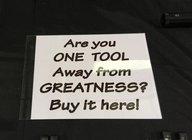Hi all, I bought a new lathe that only came with a big tool rest. I would like to get some smaller tool rests. There are a lot of choices out there. I was curious as to other peoples opinion. Are there any real differences? Quality? Is one better than the other? Thank you all for your feedback.
-
April 2025 Turning Challenge: Turn an Egg! (click here for details) -
Congratulations to Kelly Shaw winner of the March 2025 Turning Challenge (click here for details) -
Congratulations to Ellen Starr for "Lotus Temple" being selected as Turning of the Week for 21 April, 2025 (click here for details) -
Welcome new registering member. Your username must be your real First and Last name (for example: John Doe). "Screen names" and "handles" are not allowed and your registration will be deleted if you don't use your real name. Also, do not use all caps nor all lower case.
You are using an out of date browser. It may not display this or other websites correctly.
You should upgrade or use an alternative browser.
You should upgrade or use an alternative browser.
Tool Rest Thoughts
- Thread starter Craig Horrocks
- Start date
Hi all, I bought a new lathe that only came with a big tool rest. I would like to get some smaller tool rests. There are a lot of choices out there. I was curious as to other peoples opinion. Are there any real differences? Quality? Is one better than the other? Thank you all for your feedback.
I have about twenty tool rests. Most are used occasionally, and 5-6 are in constant use.
None of the cast iron rests are used anymore. Tools don't slide as well on them as the steel or hardened steel rests......and, they dent and wear too easily.
There are a variety of makers who produce great tool rests.
I'd suggest getting some of the curved inside and outside rests, as well as some smaller straight rests....both steel and hardened steel.
At this point, you probably don't know what rests you'll use the most....so, get a few and after awhile you'll know what you like best.
-----odie-----
- Joined
- Apr 27, 2004
- Messages
- 9,155
- Likes
- 5,759
- Location
- Lakeland, Florida
- Website
- www.hockenberywoodturning.com
Three rests that I use are the standard cast iron rest that came with my lathe and
The 6” comfort rest from Robust - great for reverse turning the bottom of bowls & HFs. Spheres, finials, ornaments …
The 14” J rest from robust - great for howling bowls larger than 14”
Regarding curved rests - there are two camps - those that can’t turn without them and those that can’t turn with them.
I’m a can’t turn with them - Curved rest just get in my way. The J rest gets to the bottom of bowls if I need support there for a scraper. It also gets down into the bowl with nothing sticking out.
I got my comfort rest at a symposium. I was doing a demo someone in the audience loaned me their brand new 6” comfort rest.
I liked it so much - my first stop after the demo was the Craft supplies booth to buy a comfort rest.
The 6” comfort rest from Robust - great for reverse turning the bottom of bowls & HFs. Spheres, finials, ornaments …
The 14” J rest from robust - great for howling bowls larger than 14”
Regarding curved rests - there are two camps - those that can’t turn without them and those that can’t turn with them.
I’m a can’t turn with them - Curved rest just get in my way. The J rest gets to the bottom of bowls if I need support there for a scraper. It also gets down into the bowl with nothing sticking out.
I got my comfort rest at a symposium. I was doing a demo someone in the audience loaned me their brand new 6” comfort rest.
I liked it so much - my first stop after the demo was the Craft supplies booth to buy a comfort rest.
Last edited:
I haven't used cast iron tool rests in years, and will never use them again. I have one Vicmark lathe, and it came with a rod of some sort on top of the straight rest, but it isn't hardened drill rod. After my first time using a hardened drill rod tool rest, which was from Robust, I was hooked. Most of this is because my turning tools just glide over the surface. The rest of the reason is that they just don't dent or ding. As for bowl rests, I always use an S shaped rest. I designed my own, but running the business took up too much of my play time, so I quit. Now Robust is making a similar tool rest, but I haven't seen one yet, so don't really know how they perform. I prefer the S shaped rests because as a production bowl turner, they save a lot of time. You don't have to move your banjo or tool rest around nearly as much as you do if you are using a straight rest. Other benefits of the S shaped rests are that they work well on both inside and outside the bowl, and you can keep your tools closer to the work, meaning you are not hanging out so far off the tool rest. I think Robust has been making the hardened drill rod tool rests longer than anyone out there, and may have been the first to make them. I know Steve Sinner also makes some.
robo hippy
robo hippy
I don't have the number that Odie does, but 4 of my 7 tool rests gather dust 98% of the time (all cast iron). My 12" Robust rest easily gets used 90% of the time for me, with the other two shorter Robust rests filling out the remainder of the time. I'm about to order a 14" J Robust as soon as Craft Supply gets them back in stock, I suspect this will be beneficial on larger, or deeper, bowls - looking forward to trying it.
BTW - glanced at my posts this morning related to another thread: My Robust post is not damaged at all by the PM3520 screw banjo hold, but noticed lots of deformation marks on the original PM cast iron rest; even though the post on the PM rest isn't cast iron, it's certainly not as hard as the steel on the Robust posts.
BTW - glanced at my posts this morning related to another thread: My Robust post is not damaged at all by the PM3520 screw banjo hold, but noticed lots of deformation marks on the original PM cast iron rest; even though the post on the PM rest isn't cast iron, it's certainly not as hard as the steel on the Robust posts.
Hi Craig, Congrats on the new lathe!Hi all, I bought a new lathe that only came with a big tool rest. I would like to get some smaller tool rests. There are a lot of choices out there. I was curious as to other peoples opinion. Are there any real differences? Quality? Is one better than the other? Thank you all for your feedback.
Thanks for asking the question about tool rests. I completely agree! Big tool rests are too big, and small tool rests are too small. The one I use for all of my turnings is a 9" and has a very steep angle to the rest, because many of the cuts that I do require the handle to be way down.
I also prefer a softer steel on the edge - I can easily fix knicks in the tool rest, not so much tools.
The tool rest that I sell also has one more advantage over others:
The adjustment nut on the tool rest let's you easily maintain the height of the tool rest when repositioning.
(Not to mention the advantages in hollowing).
Hope this helps in your selection!
Regards,
Lyle
Last edited:
john lucas
AAW Forum Expert
I have a custom made mini tool rest from Robust tools. It's 10 3/4" long. I bought it to make my hand mirror handles. Then I have a 9" off center round rest from Bestwoodtools.com. I have my normal 6" Powermatic rest and then I have really short rest 4" I think that I got from a wood vendor at the TAW symposium. I think Steve Sinner makes some short rests but don't remember.
As I have 3 lathes and a bunch of tool rest to use on them, some steel and some cast Iron (not all cast iron is the same quality), tools slide well on steel and cast iron as well, I don't remember the last time I needed to file a rest because it got damaged, but if it does, it takes but a minute or two with a file to smoothen it out again.
Now for my large lathe where I build and use the outboard for turning large pieces, I did make my tool rests, 1 3/8 stem on them, so these are all steel, and steep as I like to hold the turning tools low, where one can not do this turning inboard.
I have long and short tool rests and a couple J rests, often the long straight rest is used for turning inside the bowls, unless I need to go deeper where I will use the J rest.

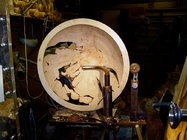
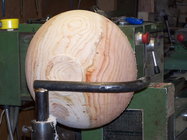
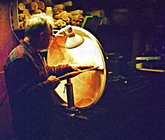
Now for my large lathe where I build and use the outboard for turning large pieces, I did make my tool rests, 1 3/8 stem on them, so these are all steel, and steep as I like to hold the turning tools low, where one can not do this turning inboard.
I have long and short tool rests and a couple J rests, often the long straight rest is used for turning inside the bowls, unless I need to go deeper where I will use the J rest.




I like the impact absorbing cast iron mass of the Nova Wood Surfer Bowl Rest for doing roughing down interrupt cuts on large irregular blanks like root balls. It is only suitable for the outside, but by the time I get to the inside a regular tool rest will do. Being cast iron it will ding slightly but an occasional visit to the belt sander and some brief work with a file restores the top edge quick enough.
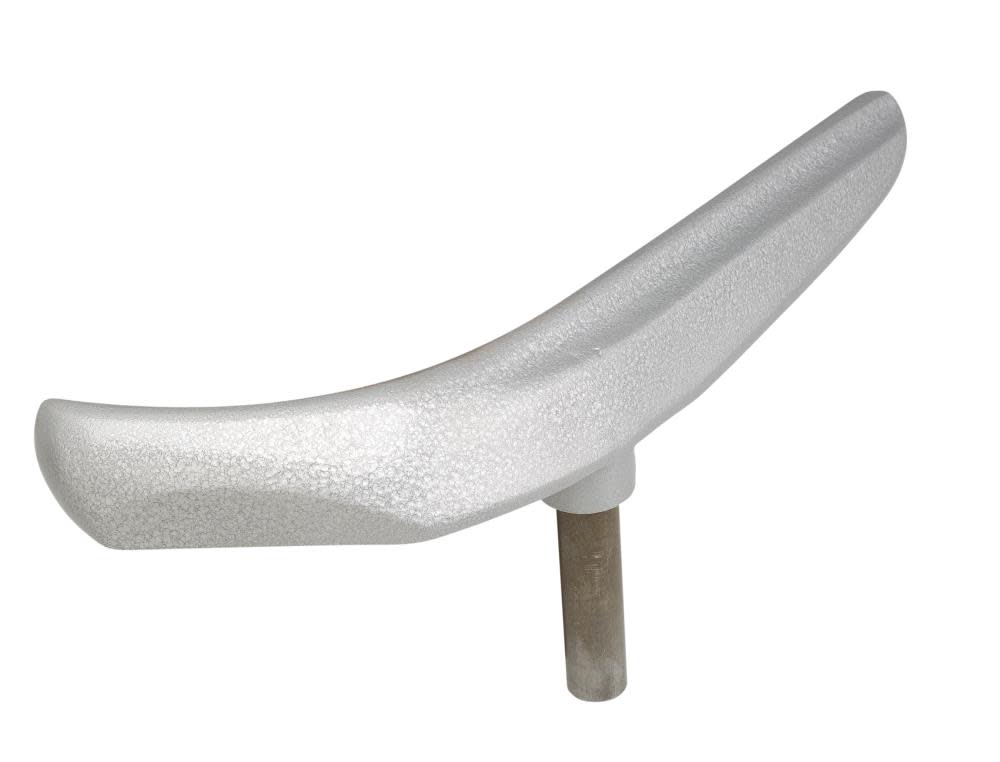
 www.acmetools.com
www.acmetools.com
I do have one S tool rest with hardened rod on the top edge, but don't find myself reaching for it very often, so perhaps I don't notice any benefit from using that over my other rests.

Wood Surfer Bowl Rest with 1 In. Post 9006 from NOVA - Acme Tools
Wood Surfer Bowl Rest with 1 In. Post - 9006 from NOVA
I do have one S tool rest with hardened rod on the top edge, but don't find myself reaching for it very often, so perhaps I don't notice any benefit from using that over my other rests.
This has been great information thank you all. I get the cast iron / hard steel difference but what about the more standard thinner edge tool rest verse the bigger bar rest. Is there much functional difference or is it just preference?
I am glad you asked, Craig. I have enjoyed the info.
The thinner edge allows the fulcrum point of the tool - where the rest supports the tool - to be closer to the. surface being cut. Bigger bars move the support point away from the work.
The other issue is how much the handle can be dropped before the tool is pulled away from the rest.
I like the Robust low profile rest - either 9 or 12" long - as my main rest in most cases. It allows a low handle posiiton for shear scraping and is great for finishing cuts Their comfort rests work well when roughing with a little more protection from shavings. A very narrow comfort rest is great for finials.
A J-Rest handles the inside of bowls extremely. well. I just added a Robust S-Rest and have been using it on the inside of open form bowls with success.
The rests that seldom get used anymore are the curved rests - inside and outside. I just don't find them to fit my turning style very. well.
The other issue is how much the handle can be dropped before the tool is pulled away from the rest.
I like the Robust low profile rest - either 9 or 12" long - as my main rest in most cases. It allows a low handle posiiton for shear scraping and is great for finishing cuts Their comfort rests work well when roughing with a little more protection from shavings. A very narrow comfort rest is great for finials.
A J-Rest handles the inside of bowls extremely. well. I just added a Robust S-Rest and have been using it on the inside of open form bowls with success.
The rests that seldom get used anymore are the curved rests - inside and outside. I just don't find them to fit my turning style very. well.
Last edited:
I believe what you are asking is about the part of the tool rest between the post and the edge. Those with a shorter amount of material here are better for people who wrap their fingers around the rest. The ones with more material in this area are supposed to provide a better resting spot for your hand. (edit--Jeff was posting his note while I was typing. He makes very good points)This has been great information thank you all. I get the cast iron / hard steel difference but what about the more standard thinner edge tool rest verse the bigger bar rest. Is there much functional difference or is it just preference?
The size and type of rest that will work best depends on the size of lathe you have and what sort of turning you do. For basic, straight rests, Robust rests are highly regarded and they come in a bajillion lengths and configurations. The general consensus here on the forum, based on my reading of many posts over time, is that the rests that have a round bar (maybe 3/4" diameter or so) for the tool rest part are not desirable.
I have as many if not more than Odie and most are cast iron. I have the set of Robo rests with the hardened tops but those are the only ones that are not cast iron. The only time I have to file some of the cast ones is after a club hands on. I did purchase a couple of the Robust rest when they first came out but felt like the tools were singing when using them so I sold them. The Robo rest are designed so well for me that I will put up with a little singing feeling when using them. Cast iron rests on cast iron lathes.
- Joined
- Apr 27, 2004
- Messages
- 9,155
- Likes
- 5,759
- Location
- Lakeland, Florida
- Website
- www.hockenberywoodturning.com
I like my tools to slide over the rest with no perceptible friction.This has been great information thank you all. I get the cast iron / hard steel difference but what about the more standard thinner edge tool rest verse the bigger bar rest. Is there much functional difference or is it just preference?
I don’t find much difference in a trued and waxed cast iron rest and a steel rod rest except that the cast iron requires a few minutes maintenance a couple times a month.
I find the large rod rests uncomfortable to use and not a good choice when pull cutting with the handle low.
They do work and I often use them in demos. Lots of folks use them.
With large rods, Lowering the handle pulls the tool further off the wood than the smaller rods. It’s another variable that I can adjust to just means raising and lowering the rest more with a larger rod than a narrow rod.
The large bar makes a parting tool cut move through a much larger arc to maintain the pealing cut. Just a little more work…
Thank you. This information has been very helpful to me. Based on this thread I think I will start with a robust low profile rest. Quick question for @Lyle Jamieson, I looked at your rest and liked the threaded rod for some applications. I assume you still need to secure it from turning left / right with the lock down lever. Does that affect the threads at all?
Well said Allen....I like my tools to slide over the rest with no perceptible friction.
I don’t find much difference in a trued and waxed cast iron rest and a steel rod rest except that the cast iron requires a few minutes maintenance a couple times a month.
I find the large rod rests uncomfortable to use and not a good choice when pull cutting with the handle low.
They do work and I often use them in demos. Lots of folks use them.
With large rods, Lowering the handle pulls the tool further off the wood than the smaller rods. It’s another variable that I can adjust to just means raising and lowering the rest more with a larger rod than a narrow rod.
The large bar makes a parting tool cut move through a much larger arc to maintain the pealing cut. Just a little more work…
I have Lyle's threaded post rest for hollowing. I haven't noticed any thread damage from the lock but I have a Oneway banjo. No doubt the post could be galled by excessive screw pressure directly on the threads.
The threaded post design is great for getting the tool centered exactly in the bottom of a hollow form. The bar is quite soft though and needs frequent attention, and in my opinion would be improved by a hardened top surface.
I have several of Robust low profile comfort rests which I like. Straight tool rests work fine for me on outside curves but I do prefer the j shape for getting at the bottom of deep bowls. Even having a j-rest I sometimes find myself reversing a straight rest to reduce the overhang in that area.
The threaded post design is great for getting the tool centered exactly in the bottom of a hollow form. The bar is quite soft though and needs frequent attention, and in my opinion would be improved by a hardened top surface.
I have several of Robust low profile comfort rests which I like. Straight tool rests work fine for me on outside curves but I do prefer the j shape for getting at the bottom of deep bowls. Even having a j-rest I sometimes find myself reversing a straight rest to reduce the overhang in that area.
Thanks for the mention Kevin.
The threaded post is hardened, but the threads will still get bunged up over time. But that is down in the banjo and we never need to take the nut off.
It will not affect the function.
Regards,
Lyle
The threaded post is hardened, but the threads will still get bunged up over time. But that is down in the banjo and we never need to take the nut off.
It will not affect the function.
Regards,
Lyle
Hi Craig.Thank you. This information has been very helpful to me. Based on this thread I think I will start with a robust low profile rest. Quick question for @Lyle Jamieson, I looked at your rest and liked the threaded rod for some applications. I assume you still need to secure it from turning left / right with the lock down lever. Does that affect the threads at all?
I use my tool rest for everything. It is universal in its applications. The nut keeps the height when moving the tool rest in a bowl and other turnings other than hollow forms, that is what it was designed for.
The threaded post is hardened, but the threads will still get bunged up over time by the lock down mechanism. But that is down in the banjo and we never need to take the nut off.
It will not affect the function.
Regards,
Lyle
I did try a couple of the 1 inch round bar tool rests and didn't like them. Main reason was that if I lifted or lowered the handles of my tools, the fulcrum point would move, and to me, that is not a good thing. The one exception is the D Way box tool rests. The top is about 1/2 inch case hardened stainless steel. When turning small boxes, they are ideal, and I don't move the handle much.
robo hippy
robo hippy
Tool rests are tools, so the best tool for the job maxum applies. What YOU need depends on what you are making and how you are approaching it.
One typically plays with the rest you get with the lathe! Over time, one tries new rests and sees the differences thus creating preferences. As with most aspects of turning tools, keep buying them, it’s quite an important part of R&D, I didn’t make the rule, I just try to live by it….it’s OK! Of course my Wife calls BS with this line of thought….anyone got anything better, lol?Tool rests are tools, so the best tool for the job maxum applies. What YOU need depends on what you are making and how you are approaching it.
As a member of our local club claims: I'm only one tool away from being a good turner.
wow, was ready to add my two cents, but by the time I got to the of this thread..... nothing I could say hadn't already been said? a lot of good information here. I will say that for me Robust tool rests rule. Love my larget and small J style. use them all the time
Thank you all for your responses to my question. As a result I ended up getting a robust 6" an 9" tool rest. Originally I was just looking for a 6" but based on the responses I got I ended up buying the 9 as well. So far I really love the 9" and I'm really appreciative of the advice I got. Thank you.
Also forgot to mention, I use soft cold rolled steel for the tool rest intentionally. I do not want a hardened rod on the tool rest to damage and dimple my turning tools. I want the tool rest softer than the tools we use. I can clean up the tool rest damage easily to keep it running smooth.
I already weighed in earlier, but, after a look on the Robust website I noticed something new in their tool rests I think bears mention - they now have a special rest for sheer scraping. It allows the tool handle to be dropped lower than any of their other rests (Something I’d been wishing for for a long time). I had found that their s-rests Allowed me to drop the handle lower and had been trying to find a way to use it for sheer scraping, but couldn’t quite get comfortable with it for that use. This looks perfect - guess I‘m getting a new rest soon…
Learn something new every day. I knew about the new S rests, but not the SS shear scrape one's. I have a couple of @robo hippy 's rests which are very similar to the S rests, they work great. I would have invested in these shear scrape type had they been available a few years ago. I have found that raising the comfort rest up allows the tool edge to get to the proper geometry for shear scraping and allow handle clearance, but for those in the market for new rests, the shear scrape style would be the one's to get.after a look on the Robust website I noticed something new in their tool rests I think bears mention - they now have a special rest for sheer scraping.
I haven't seen the shear scraping tool rest, but with my S rests, no problem doing shear scraping. I do use a scraper with a heavy burr that is burnished. No problem dropping the handle with my rests, and the Robust one is pretty much a clone of mine. I designed it for turning the inside of a bowl, but it works great for the outside as well.
robo hippy
robo hippy
john lucas
AAW Forum Expert
If your banjo has enough depth to the tool post simply take your tool rest to a machinist and have a little cut off the tool post. Some banjos are too tall and won't let you lower the tool rest.
I have a couple of Steve Sinner's tool rests that I use for shear scraping ... it appears to be similar to the sheer scrape rests Robust has come out with. In my experience, both Steve and Brent English will cut the post to whatever length you need.
Good tool rests are expensive..... I have a well equipped metalworking shop so I decided to make some. The first was the Robust Comfort Rest. I forged and shaped the lower part. Next I welded a high carbon 0-1 round rod to the top. Final step was to heat treat so the top was really hard. This rest took some time to make. Welding 0-1 steel is really difficult due to the high carbon content. When I got finished I found I did not like the rest because of the difficulty in shear cutting and shear scraping. I shear cut more than anything.
Next I copied Steve Sinners rests and used ordinary 1018 cold rolled steel for the round rod. Easy to make and I like using them but cold rolled is pretty soft as steels go.
Third attempt was using 4130 alloy steel for the top. This was perfect as its easy to weld and almost as hard as real tool steel. I made different lengths of tool rests and even a few "J" rests exactly how I wanted.
So.....If you have a welder, grinder, and hacksaw you can make a bunch of great tool rests exactly as you want at a lot less cost than what is on the market.
Next I copied Steve Sinners rests and used ordinary 1018 cold rolled steel for the round rod. Easy to make and I like using them but cold rolled is pretty soft as steels go.
Third attempt was using 4130 alloy steel for the top. This was perfect as its easy to weld and almost as hard as real tool steel. I made different lengths of tool rests and even a few "J" rests exactly how I wanted.
So.....If you have a welder, grinder, and hacksaw you can make a bunch of great tool rests exactly as you want at a lot less cost than what is on the market.
Looked up the shear scrape tool rest from Robust. For bowls, I wouldn't use it since the S rest will do the same thing, and it fits up really close to the wood.
robo hippy
robo hippy
I have the cast iron original 14", several Robust rests, and the modular BestWoodTools system. I like them all. But still want more rests. From Robust, I want a large and small S, and a 12" low profile (never ending tool fettish). The modular BWT is larger round rods. The shape doesn't bother me. One thing I like about them is that the low profile fits better inside small openings. The offset rod is also good for that, as it moves the post further from the wood. They are also good for shear cuts. And their little baby box rest is the bomb for quick small box work. And the whole set easy to store in a small tray in a drawer.
- Joined
- Apr 8, 2009
- Messages
- 17
- Likes
- 5
After having owned many cheaper toolsets, I have finally chosen Robust toolrests and couldn't be happier.

